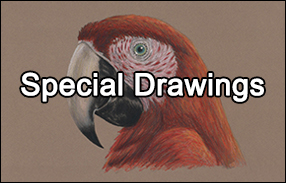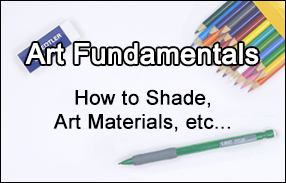In just a few steps, you'll learn how to draw this golden retriever dog. All the tutorials on How2DrawAnimals.com are easy to follow and great for beginners and experienced artists alike. Get art basics while sketching your favorite animals step by step. Each free tutorial on this site has a video tutorial option, as well as step-by-step photos and written text to follow along with. Have fun drawing!

Stay tuned for more free drawing lessons by:
Liking us on Facebook>>
Subscribing on YouTube.com>>
Following us on Instagram>>
To draw this golden retriever dog step by step, follow along with the video tutorial below and pause the video after each step to go at your own pace. You may find it easier to follow the step-by-step images below the video. The new lines in each step are shown in red, so you'll know exactly what to sketch next. You may want to open the video in a new tab and use both drawing methods. Take your time and create art at your own pace.
Below you can watch a narrated step-by-step video tutorial:
For the first few steps, don't press down too hard with your pencil. Use light, smooth strokes to begin so that it's easy to erase if you make a mistake.

Step 1: Draw two circles as guides for the golden retriever's body and one smaller one for the head. The edges of the circles should touch.
DRAWING TIP: To draw a circle, first draw four small marks for the height and width of the circle, and then connect the marks using curved lines. Sketch lightly at first so that it's easy to erase if you make a mistake. But the circles don't have to be perfect. They're just guides.

Step 2: Draw a curved horizontal line across the golden retriever's head. This is a construction line that will help you place the dog's facial features later. Add a curved vertical line on the top left side of the head for another construction line.
Sketch in guides for three of the dog's legs. Two relatively straight lines come down from the middle circle, with short horizontal lines at the ends for the feet. A curved C-like shape and a longer line on the bottom circle will be your guide for drawing the visible hind leg.

Step 3: Draw a small circle on the lower half of the head as a guide for the dog's muzzle. The top edge of this circle should touch the construction line, and the bottom edge should be outside of the head.
Sketch the guides for the ears with straight lines on the sides of the head. Pay attention to the size of the ear shapes in relation to the golden retriever's head.

Step 4: Draw two lines that connect the head to the body to form the guide for the neck. Now draw two longer lines that connect the first two circles to complete the guide for the golden retriever's body. Draw a curved line on the upper, right side of the body as a guide for the tail.
That's it for the guidelines! From this point on, press down harder with your pencil for a more defined rendering of a golden retriever dog.

Step 5: Use the construction lines as guides for the placement of the eyes. Make the shape of the dog's eyes a bit more narrow and add a pointy tip to the sides. Inside each eye, near the middle, draw a tiny dot for the pupils and add a tiny circle to the left of each pupil to represent glare.
Use a series of quick, short pencil strokes above the eyes for the dog's brows. Add a few lines under each eye for more fur.
Place the golden retriever's nose inside the muzzle circle using a series of curved shapes. Add slits for the nostrils and a short vertical line at the bottom, middle part of the nose.

Step 6: Add some short lines above the nose, and begin drawing the mouth underneath. The upper and lower lips are like parallel W shapes. Shade in a little section just under the nose to represent the dark lip pigment.

Step 7: Use the angled lines on the sides of the head as guides to draw the golden retriever's ears. Follow the basic path of the guides but use quick, short pencil strokes to represent fur. Also make the sides more wavy and the bottom edges rounder.
Draw the top part of the dog's head. Then add a few vertical lines made up of short pencil strokes for the loose skin found on the neck.

Step 8: Follow the paths of the leg guides to lightly sketch the dog's front limbs. Darken the lines when you get the shapes of the legs right, adding some longer fur on the right side and toes and nails at the bottom. The fur on the chest will cover much of the leg on the other side, so don't worry about drawing the leg all the way up.

Step 9: Now add the golden retriever's hind leg and tail. Use curved lines for the top of the leg (and a bit of the side of the tummy) and a straight line at the bottom of the foot. Add the dog's toes and tiny nails. Draw the back of the leg and the tail with longer pencil strokes to represent the fur, and a smooth curve for the side of the tail.

Step 10: Complete the golden retriever's body with quick, short strokes along the path of the guides to create a furry texture. Use slightly longer strokes along the underside of the body for longer fur. To indicate the smoother fur on the dog's back, simply darken the outer edges of the initial guides.

Step 11: For a cleaner look, erase as much as you can of the initial guide lines. Don't worry about erasing all of the guides. It's okay to leave some behind. Re-draw any final sketch lines you may have accidentally erased.

Final Step: Add some shading to your golden retriever drawing to give it more dimension and volume. Use a dark value for the dog's nose and around the eyes.
Pick the direction of the light source when shading so that the shadows are consistent with it. Vary the pressure on your pencil to get different degrees of tonal value. Continue shading until the entire body has the appropriate shadows.
Add a cast shadow underneath. This helps ground the dog so it doesn't appear to be floating. Use a lighter value along the edge for the shadow's diffusion.
You can add even more value throughout your drawing for extra detail. Golden retrievers don't have any pattern on their coats like spots or stripes, so just add a medium value to the whole body. Use shorter stokes when you add the value to the head as opposed to the longer strokes you will use for the body. As you add the value, separate each individual stroke a bit so that the white of the paper comes through and creates a furry-looking texture.
Use strokes that go in the general direction of the fur as you add the value. The strokes on the golden retriever's chest should have a vertical orientation, while farther back along the body, the strokes should be angled. Don't worry about shading too smoothly. The rough value gives the dog's coat a furry texture.
Shading can be time-consuming, so be patient and take breaks. If you have a pet golden retriever or a similar breed, try to duplicate its characteristics on your drawing!
Thanks for visiting! Subscribe to the How2DrawAnimals YouTube Channel for a new tutorial every week.
To learn how to draw popular cartoon characters, visit EasyDrawingTutorials.com.
To learn how to draw Manga, visit How2DrawManga.com.
RELATED TUTORIALS
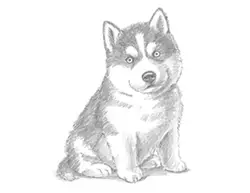 |
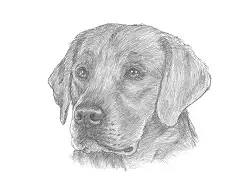 |
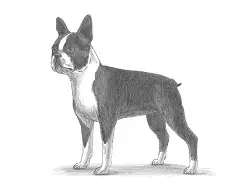 |






